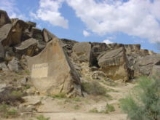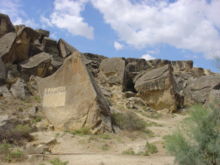
Qobustan, Baku
Encyclopedia
Qobustan is a settlement and municipality in Baku
, Azerbaijan
. It has a population of 14,470.
Qobustan is best known for being the home to the famous rock petroglyphs and mud volcanoes.
The area has been settled since the 8th millennium BC. It is known for hosting thousands of rock engravings spread over 100 square km depicting hunting scenes, people, ships, constellations and animals. Its oldest petroglyph
s date from the 12th century BC. In 2007, UNESCO
included the 'Gobustan Rock Art Cultural Landscape' in the World Heritage list
. The Gobustan State Reserve
was featured during the Thirty-third Session of the Islamic Conference of Foreign Ministers.
 There are inscriptions nearby left by a Roman Legionaire around 75AD during the reign of Emperor Domitian which is the eastern-most Roman inscription ever found. Gobustan is also famous for its mud volcanoes. Nearly 300 of the world's 700 mud volcanoes are located in this part of eastern Azerbaijan near the Caspian Sea. Additionally, near Maraza in this area, there is the mausoleum of Sufi
There are inscriptions nearby left by a Roman Legionaire around 75AD during the reign of Emperor Domitian which is the eastern-most Roman inscription ever found. Gobustan is also famous for its mud volcanoes. Nearly 300 of the world's 700 mud volcanoes are located in this part of eastern Azerbaijan near the Caspian Sea. Additionally, near Maraza in this area, there is the mausoleum of Sufi
mystic Diri Baba (which translates to "Living Grandfather") built in 1402.
Baku
Baku , sometimes spelled as Baki or Bakou, is the capital and largest city of Azerbaijan, as well as the largest city on the Caspian Sea and of the Caucasus region. It is located on the southern shore of the Absheron Peninsula, which projects into the Caspian Sea. The city consists of two principal...
, Azerbaijan
Azerbaijan
Azerbaijan , officially the Republic of Azerbaijan is the largest country in the Caucasus region of Eurasia. Located at the crossroads of Western Asia and Eastern Europe, it is bounded by the Caspian Sea to the east, Russia to the north, Georgia to the northwest, Armenia to the west, and Iran to...
. It has a population of 14,470.
Qobustan is best known for being the home to the famous rock petroglyphs and mud volcanoes.
The area has been settled since the 8th millennium BC. It is known for hosting thousands of rock engravings spread over 100 square km depicting hunting scenes, people, ships, constellations and animals. Its oldest petroglyph
Petroglyph
Petroglyphs are pictogram and logogram images created by removing part of a rock surface by incising, picking, carving, and abrading. Outside North America, scholars often use terms such as "carving", "engraving", or other descriptions of the technique to refer to such images...
s date from the 12th century BC. In 2007, UNESCO
UNESCO
The United Nations Educational, Scientific and Cultural Organization is a specialized agency of the United Nations...
included the 'Gobustan Rock Art Cultural Landscape' in the World Heritage list
World Heritage Site
A UNESCO World Heritage Site is a place that is listed by the UNESCO as of special cultural or physical significance...
. The Gobustan State Reserve
Gobustan State Reserve
Gobustan National Park officially Gobustan Rock Art Cultural Landscape is a hill and mountain site occupying the southeast ending of the Big Caucasian Ridge, mainly in the basin of Jeyrankechmaz River, between the rivers Pirsagat and Sumgait...
was featured during the Thirty-third Session of the Islamic Conference of Foreign Ministers.

Sufism
Sufism or ' is defined by its adherents as the inner, mystical dimension of Islam. A practitioner of this tradition is generally known as a '...
mystic Diri Baba (which translates to "Living Grandfather") built in 1402.

